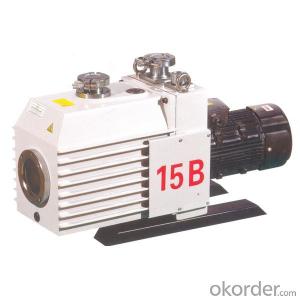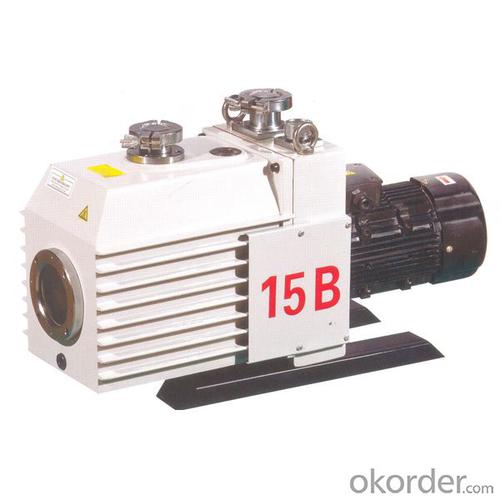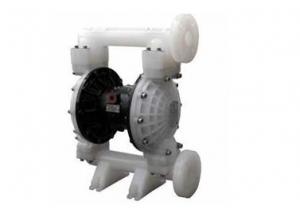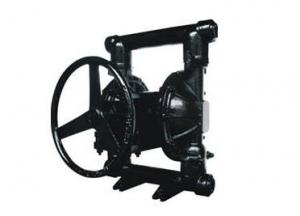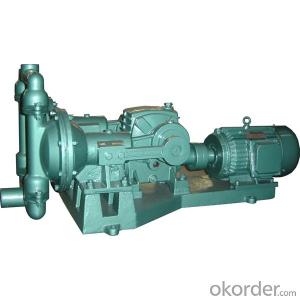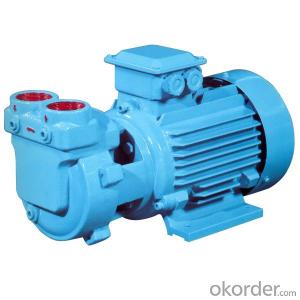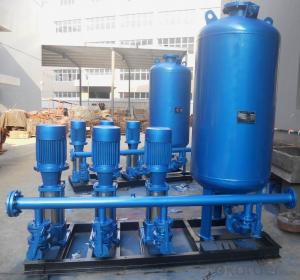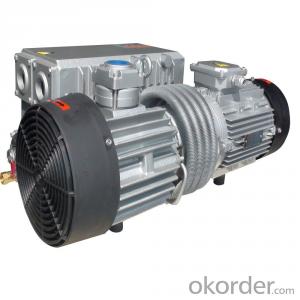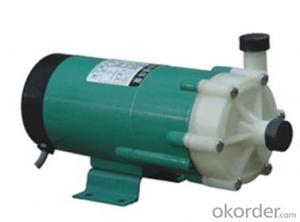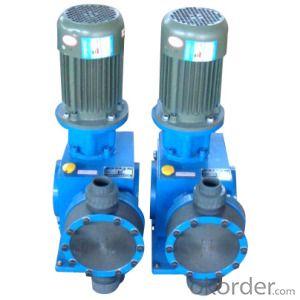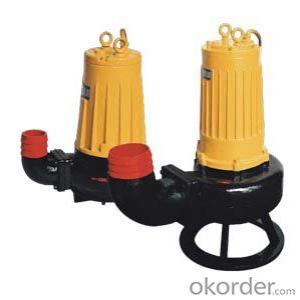Vacuum Pumps 2XZ-B
- Loading Port:
- China Main Port
- Payment Terms:
- TT OR LC
- Min Order Qty:
- -
- Supply Capability:
- -
OKorder Service Pledge
OKorder Financial Service
You Might Also Like
. High speed, Iow volume, light weight, equipped with noise reducer, low noise, less shake. Pump stop and oil returnprevention is equipped, so that pupm oil is prevented to get back to the pump once pump stopped working, which makes it easy to restart.2. Gas valve is installed in order to separate the vapor from the gas, when pumping gas mixed with vapor. The valve prohibited the entrance of the vapor, ensured the purity and prolonged the use of the pump oil.3. Vent is applied with oil fog capture mchine to eliminate oil fog when discharge the gas. Ol collecting equipment is installed around the oil sal, in order to preven oil leaking, and entironment pollution.Motor power:0.37~1.5KW,extract capacity2~15L/S,Limit vacuum:2×10-2Pa。
List of performance
 | Unit | 2XZ-2B | 2XZ-4B | 2XZ-6B | 2XZ-8B | 2XZ-15B | |
off-gas quick result | L/S | 2 | 4 | 6 | 8 | 15 | |
limited pressure | Branch pressure (close gas) | Pa | 2×10-2 | 2×10-2 | 2×10-2 | 2×10-2 | 2×10-2 |
General pressure (close gas) | Pa | 6×10-1 | 6×10-1 | 6×10-1 | 6×10-1 | 6×10-1 | |
Branch pressure (open gas) | Pa | 6×10-1 | 6×10-1 | 6×10-1 | 6×10-1 | 6×10-1 | |
General pressuer (open gas) | Pa | 9×10-1 | 9×10-1 | 9×10-1 | 9×10-1 | 9×10-1 | |
Noise (close gas) | dB(A) | 60 | 60 | 65 | 70 | 70 | |
Working temperature | ℃ | 80 | 80 | 80 | 85 | 85 | |
electric machine | Voltage | V | 380/220 | 380/220 | 380/220 | 220/380 | 220/380 |
Power | Kw | 0.37 | 0.55 | 0.75 | 1.1 | 1.5 | |
Rotate speed | r/min | 1420 | 1420 | 1420 | 1400 | 1400 | |
Weight | Kg | 23 | 30 | 40 | 70 | 90 | |
Shape&size (L×W×H) | mm | 560×190×230 | 570×190×230 | 570×190×230 | 600×230×420 | 690×230×420 | |
- Q: Is there any difference between an air pump and a compressor?
- Yes, there is a difference between an air pump and a compressor. While both devices are used to move air, they serve different purposes and have distinct characteristics. An air pump is typically a smaller, portable device used to inflate items such as air mattresses, sports balls, and bicycle tires. It works by manually or electrically pumping air into a closed space, increasing the air pressure inside the item being inflated. Air pumps are generally designed for low-pressure applications and are not suitable for heavy-duty or high-pressure tasks. On the other hand, a compressor is a more powerful and versatile device used to generate high-pressure air. It is commonly used in industrial settings, construction sites, and automotive repair shops. Compressors work by sucking in air from the surrounding environment and compressing it to a higher pressure, which is then stored in a tank for later use. Compressors are capable of generating much higher pressures than air pumps and are equipped with various features such as pressure regulators, gauges, and safety valves. In summary, the main difference between an air pump and a compressor lies in their size, power, and intended applications. Air pumps are smaller, less powerful, and suitable for low-pressure tasks like inflating small objects. Compressors, on the other hand, are larger, more powerful, and designed for generating high-pressure air for a wide range of industrial and commercial applications.
- Q: Can an air pump be used for pumping oil?
- Using an air pump to pump oil is not possible. Air pumps are designed exclusively for handling air or gases, so they lack the capability to manage the thicker consistency of oil. The internal mechanisms and components of an air pump are not constructed to withstand the requirements of oil pumping. Trying to utilize an air pump for this task may lead to pump damage and potential safety risks. To ensure efficient and safe operation, it is crucial to employ the appropriate type of pump that is specifically designed for pumping oil.
- Q: What is the recommended air pressure for different types of inflatables?
- The recommended air pressure for different types of inflatables can vary depending on the specific item. However, as a general guideline, here are some recommendations for common inflatables: 1. Pool floats and inflatable toys: These typically require a lower air pressure, usually around 1-2 PSI (pounds per square inch). It is important to avoid over-inflating them as it can put strain on the seams and lead to damage. 2. Air mattresses: Most air mattresses recommend an air pressure of around 6-8 PSI. However, it is essential to check the specific instructions provided by the manufacturer, as some models may have different requirements. 3. Balloons: Regular latex balloons usually require an air pressure of around 0.5 PSI. Over-inflating balloons can cause them to burst, so it is crucial to follow the recommended guidelines. 4. Inflatable boats and kayaks: The air pressure for these types of inflatables can vary depending on the size and material. Generally, the recommended range is between 2-3 PSI, but it is essential to consult the manufacturer's instructions for accurate guidelines. 5. Gym/exercise balls: The recommended air pressure for gym or exercise balls can vary depending on the size and intended use. As a general rule, most exercise balls require an air pressure of around 4-5 PSI. However, it is crucial to verify the specific instructions provided by the manufacturer. Remember, these recommendations are general guidelines, and it is always best to consult the manufacturer's instructions for accurate and specific air pressure recommendations for your particular inflatable item. Over-inflating or under-inflating can impact the performance, durability, and safety of the inflatable, so it is crucial to follow the recommended guidelines.
- Q: 0.25 can the air pump drive the tire machine?
- 0.25 of the air pump can not drive the tire machine, 0.25 tires are not enough, and 0.75 cubic meters of 8 kilograms can.An air pump, an air pump, that excludes air from an enclosed space or adds air from enclosed space. The air pump is mainly divided into an electric air pump and a manual air pump. Electric air pump. An electric pump powered by electricity; produces air pressure by constantly compressing the air through electricity. Mainly used in pneumatic rubber, car inflatable, etc..Turn left and turn right |
- Q: Does the high pressure air function replace the air pump?
- High pressure air can not replace the air pump.Blowers and air pumps are not the same equipment. Said the first pump, also known as air compressor, compressed air can be stored, the pressure can be adjusted, the use of wide area; although can store a certain pressure value of the compressed air, but not a constant output value of the air pressure, can output large flow of air, the device itself does not have long-term operation ability, is described under start compression. To a certain pressure value from the stop, and then use the compressed air, emptying into the lowest pressure set value from the start to compression.There are many kinds of blower, but the characteristic is the air which can output constant pressure value. It has the ability to run for a long time, the pressure can be adjusted, and some of them are not suitable for the process of frequent starting and stopping. For example, the centrifugal blower is almost the same as the household, and the different types of blower used in the blast are very different, and the management is different.Under the design condition, the blower with the wind pressure of 30kPa~200KPa or the compression ratio of e=1.3~3 belongs to the category of high pressure blower. At present, the air ring vacuum pump is generally classified as a high pressure blower in the industry. High pressure blower, also known as high-pressure fan, is different from the general centrifugal high-pressure blower.The high pressure blower is small and easy to carry. Besides the impeller, the high-pressure blower has no other moving parts, and the impeller is directly connected with the motor without gear or drive belt. Therefore, the utility model has the advantages of high reliability and almost no maintenance.
- Q: Can an air pump be used for inflatable stage props or decorations?
- Certainly, inflatable stage props or decorations can indeed be easily inflated and deflated using an air pump. In fact, it is one of the most popular and efficient methods utilized for this purpose. Air pumps are specifically designed to swiftly and effortlessly fill up inflatables with air, enabling them to be effortlessly set up and taken down. They are available in diverse sizes and types, ranging from handheld pumps to electric pumps, and even larger industrial pumps, depending on the size and quantity of the inflatables you need to inflate. Moreover, air pumps often come equipped with various nozzles or adapters that can be adjusted to fit different types of inflatables, making them highly versatile and suitable for a wide array of stage props and decorations. Consequently, if you are seeking a convenient and effective means to inflate your stage props or decorations, an air pump would undoubtedly be an excellent choice.
- Q: Are there any disadvantages of using an air pump?
- Yes, there are a few disadvantages of using an air pump. Firstly, air pumps can be noisy, which may cause disturbance in quiet environments or during nighttime. Secondly, some air pumps can consume a significant amount of electricity, leading to increased energy costs. Additionally, air pumps can sometimes produce vibrations that may be felt or heard, which can be bothersome. Lastly, certain types of air pumps require regular maintenance to ensure optimal performance, which can be time-consuming and add to the overall cost of using an air pump.
- Q: Can an air pump be used for inflating balloons?
- Indeed, an air pump has the capability to inflate balloons. Specifically engineered to deliver a constant stream of air, these devices prove to be highly efficient and effective for the purpose of balloon inflation. Air pumps come in diverse sizes and types, including both manual and electric options. Employing an air pump guarantees a uniform and regulated expansion, simplifying the attainment of the intended size and form of the balloon. Furthermore, employing an air pump can result in time and energy savings when compared to the manual act of inflating balloons.
- Q: Are air pumps suitable for high-altitude use?
- Yes, air pumps are suitable for high-altitude use. They can effectively inflate objects such as tires, balloons, or air mattresses at high altitudes just as they would at lower altitudes. However, it is important to note that due to the lower air pressure at higher altitudes, it may take slightly longer to fully inflate objects compared to lower altitudes.
- Q: How to choose the right air pump for a specific air compressor system?
- To make an informed decision when choosing the appropriate air pump for a specific air compressor system, there are several key factors to take into account. Here are some steps that can assist you in this process: 1. Calculate the required air volume: Begin by determining the specific air volume needed for your compressor system. Take into consideration the maximum airflow requirements of the tools or equipment that will be used with the compressor. This calculation will help you establish the necessary cubic feet per minute (CFM) rating for the air pump. 2. Evaluate the pressure requirements: Assess the pressure needs of your compressor system. Different applications may necessitate varying pressure levels, so ensure that the chosen air pump can deliver the required pressure. Typically, pressure is measured in pounds per square inch (PSI). 3. Consider the power source: Determine the available power source for your air compressor system. Air pumps can be powered by electricity, gasoline, or diesel engines. Choose an air pump that aligns with the power source you possess or are willing to invest in. 4. Assess the type of pump: There are various types of air pumps available, including reciprocating, rotary screw, and centrifugal pumps. Each type has its own advantages and disadvantages, so take into account factors such as cost, maintenance requirements, noise levels, and efficiency when selecting the pump type that suits your needs. 5. Evaluate size and portability: Take into consideration the size and portability of the air pump. If you require a highly mobile compressor system, search for a smaller, lightweight pump that can be easily transported. Alternatively, if portability is not a major concern, you have the option to choose a larger, stationary pump that offers enhanced performance. 6. Compare different brands and models: Conduct research and compare various brands and models of air pumps available in the market. Read customer reviews and consider the reputation and reliability of each brand. Look for a pump that is known for its durability, performance, and after-sales support. 7. Budget considerations: Finally, consider your budget and the overall cost of the air pump. While it is crucial to invest in a high-quality pump, ensure that it falls within your budget limitations. Take into account the long-term cost of maintenance, availability of spare parts, and energy efficiency in order to make an informed decision. By considering these factors, you can select the appropriate air pump for your specific air compressor system, ensuring optimal performance and efficiency.
Send your message to us
Vacuum Pumps 2XZ-B
- Loading Port:
- China Main Port
- Payment Terms:
- TT OR LC
- Min Order Qty:
- -
- Supply Capability:
- -
OKorder Service Pledge
OKorder Financial Service
Similar products
Hot products
Hot Searches
Related keywords
